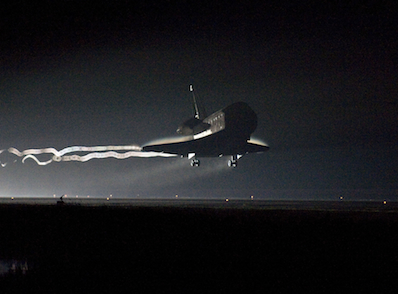

The Space Shuttle Endeavour


The space shuttle Endeavour is one NASA's three remaining shuttles that were instrumental in completing the International Space Station. It figures prominently in the crew's survival in the book, ORBITAL MANEUVERS.
Endeavour (Orbiter Vehicle: OV-105), born from the ashes of the Challenger disaster and with some spare parts from the construction of Discovery (OV-103) and Atlantis (OV-104), the sixth shuttle to be built reached for the stars on May 7, 1992, as STS-49 (Space Transportation System), after a five year construction and test program. Its first launch to capture INTELSAT VI, among other tasks was very successful.
Endeavour flew its final
mission, STS-134, coming back to Mother Earth on June 1, 2011 at
2:34 AM (EST). NASA's last shuttle to be built completed
25 missions, traveling over 122 million miles in
4,677 orbits during its 19
years of service. The image below shows the shuttle
touching-down for the last time at Florida's Kennedy Space
Center.
Endeavour was named after the HM Bark Endeavour, the ship commanded by the 18th century explorer, James Cook on his voyage in 1768 to the South Pacific to observe the transit of the planet Venus across the face of the Sun. This information would enable astronomers to find the distance between the Sun and Earth. Endeavour was also the name of the command module for the Apollo 15 mission to the Moon. The name was selected after a national competition for elementary and secondary school children to suggest a name for Challenger's replacement and write an essay explaining the recommendation. President Bush made the official announcement in May of 1989.

Endeavour incorporated a number of improvements that the rest of the shuttle fleet would eventually have installed during scheduled refits. Some of these included:
· A 40-foot drag chute that reduced the rollout distance
by 1000 to 2000 feet.
· Updated avionics, computers and navigation system
· Glass cockpit utilizing full color flat panel displays
· Improved nose wheel steering system
· Modifications for the Extended Duration Orbiter (EDO) mode, which would allow the shuttle to stay in orbit for 28 days. (The current record is 17 days, set by Columbia (OV-102))

The
space shuttle Endeavour docked at the ISS. The picture was
taken by a returning Soyuz crew.

General Shuttle Facts:
· Shuttle
Length: 122 feet (37.2m)
· Height on Runway: 57 feet
(17.4 m)
· Wingspan: 78 feet (23.8 m)
· Payload Bay Length: 60
feet (18.3 m)
· Payload Bay Width: 15 feet
(4.6 m)
· Payload Bay Height: 20
feet (6.1 m)
· Payload Capacity: 50,000
lbs (22,700 kg)
· Shuttle Weight: 172,000 lb
(78,000 kg)
· Crew Module Volume: 2,325
cubic feet (65.8 cubic meters)
· Operational Altitude: 120
to 600 mi (190 to 960 km)
· First Shuttle to Fly:
Enterprise (OV-101) - only used for approach and landing
test flights.
· First Shuttle into Orbit:
Columbia, as STS-1 on April 12, 1981
· Challenger - STS 51-L, was
destroyed on liftoff on January 28, 1986, due to the effects of
cold weather on faulty O-rings in the solid rocket
boosters.
· Columbia - STS 107
disintegrated as it returned from orbit on February 1, 2003
because of damage to the thermal protection system on the
leading edge of the left wing by insulating foam that broke
loose from the main fuel tank during launch.

©
2009-2025, RC Davison